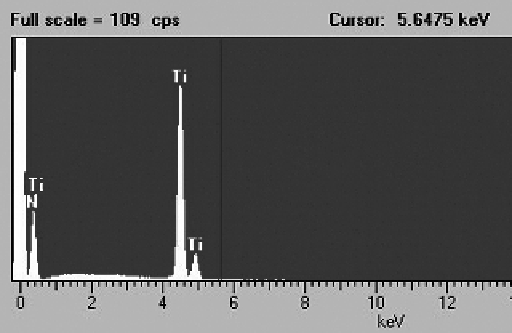Biomedical Engineering Reference
In-Depth Information
Figure 21.1.
Energy Dispersive X-ray spectra (EDX) of TiN surface showing peaks correspond-
ing to titanium and nitrogen elements.
comparison of the profi les of the sample surfaces before and after coating revealed
that there is marginal deterioration in surface fi nish while coating polymer
samples. While in the case of metal substrates the surface fi nish of the substrate
was more or less retained after the coating process (see Figure 21.2 and Table
21.4). These measurements correlated well with the surface roughness measure-
ments carried out using mechanical contact profi lometry (Surtronic 3+, Rank
Taylor Hobson Ltd, UK).
21.7.2 Adhesive Wear Characteristics
A pin-on-wheel test system is used for studying the adhesive wear properties of
the material combinations. It consists of platform rotating at a constant speed of
60 rpm and a pin loading arm for provisions for applying a constant load on the
pin. The wheel diameter is 25 mm on which the pin with 3 mm diameter contact
area is allowed to traverse in circular motion [Muraleedharan et al., 1989]. The
test conditions are described in Table 21.5.
Results from the study (see Figure 21.3) show that both DLC and TiN coat-
ings improve the wear characteristics substantially. Moreover, the wear tracks on
the UHMWPE surface is found to be more uniform and with less cracks when
articulated against coated surfaces than with uncoated metallic surfaces. The
weight loss from UHMWPE was lowest when DLC-coated pin is used as the
counter face; but TiN surface generated a smoother worn surface with minimal
track marks and best surface fi nish (see Figure 21.4 ).
UHMWPE wheels used had initial surface fi nish of the order of 0.15
m Ra.
The wear tracks generated by titanium, DLC coating, and TiN coating were
having surface roughness values of 0.47
μ
μ
m Ra, 0.16
μ
m Ra, and 0.08
μ
m Ra,
respectively.

Search WWH ::

Custom Search